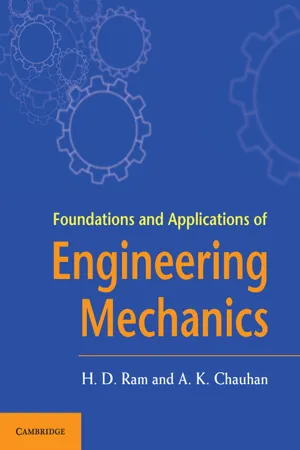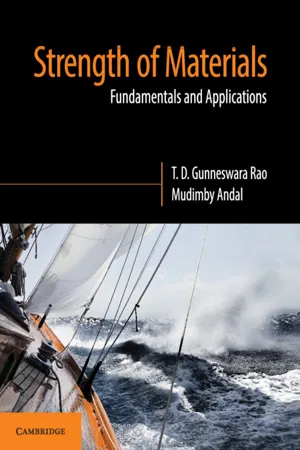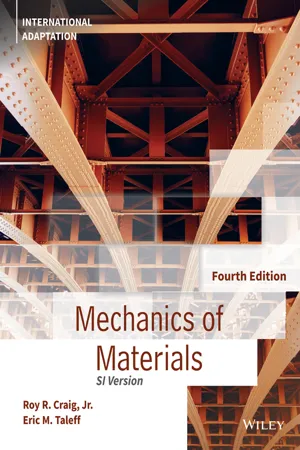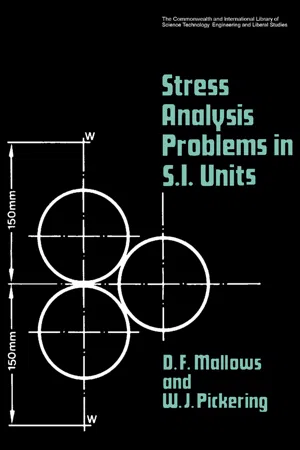Technology & Engineering
Normal Strain
Normal strain refers to the change in length of a material per unit length, caused by an applied force. It is a measure of how much a material deforms under stress, and is typically expressed as a ratio of the change in length to the original length of the material. Normal strain is an important concept in engineering and materials science for understanding the behavior of materials under load.
Written by Perlego with AI-assistance
Related key terms
1 of 5
11 Key excerpts on "Normal Strain"
- eBook - PDF
- Timothy A. Philpot(Author)
- 2014(Publication Date)
- Wiley(Publisher)
The Normal Strain at a point can be determined by decreasing the length over which the actual deformation is measured. In the limit, a quantity defined as the Normal Strain at the point (O) is obtained. This limit process is indicated by the expression ( ) li O L d dL L m 0 (2.2) Strain Units Equations (2.1) and (2.2) indicate that Normal Strain is a dimensionless quantity; however, Normal Strains are frequently expressed in units of mm/mm, m/m, m/m, or . The symbol in the context of strain is spoken as “micro,” and it denotes a factor of 10 6 . The conversion from dimensionless quantities such as m/m to units of “microstrain” (such as m/m or ) is 1 1 10 mm/mm 1 10 m/m 6 6 Since Normal Strains are small, dimensionless numbers, it is also convenient to express strains in terms of percent. For most engineered objects made from metals and alloys, Normal Strains seldom exceed values of 0.2%, which is equivalent to 0.002 m/m. Measuring Normal Strains Experimentally Normal Strains can be measured with a simple component called a strain gage. The common strain gage (Figure 2.3) consists of a thin metal-foil grid that is bonded to the surface of a machine part or a structural element. When loads (and also temperature changes) are applied, the object being tested elongates or contracts, creating Normal Strains. Since the strain gage is bonded to the object, it undergoes the same strain as the object. As the strain gage elongates or contracts, the electrical resistance of the metal-foil grid changes proportionately. The relationship between strain in the gage and its corresponding resis- tance change is predetermined by the strain gage manufacturer through a calibration pro- cedure for each type of gage. Consequently, precise measurement of resistance change in the gage serves as an indirect measure of strain. Strain gages are accurate and extremely sensitive, enabling Normal Strains as small as 1 to be measured. - H. D. Ram, A. K. Chauhan(Authors)
- 2015(Publication Date)
- Cambridge University Press(Publisher)
10 SIMPLE STRESS AND STRAIN 10.1 Introduction One of the major reasons for the failure of materials or components is stress. The understanding and analysis of stress is a very important step in any design. Our primary objective here is to identify the stress, and then discuss the scheme of analysis for simple and complex situations. 10.2 Definitions Stress is defined as the intensity of internal reaction. The intensity is measured with respect to the area. Consider a body in equilibrium under the action of certain forces as shown in Figure 10.1a. Figure 10.1a Figure 10.1b If we consider a section of the body as shown in the Figure 10.1b; it is obvious that part of the body cannot remain in equilibrium under the action of external forces alone. Some other forces must be there on the sectioned plane. These forces are due to the reaction of the other part of the body. These forces are spread over the entire section (Figure 10.1b). The intensity of this distribution is called the stress. If the force on a small area ∆A be ∆F , then the stress on the said area is given as: arrowrightnosp arrowrightnosp s F A A = → lim Δ Δ Δ 0 Simple Stress and Strain | 515 The stress on a plane is a vector. The component of the stress vector normal to the plane is called the normal stress, and the component of stress tangent to the plane is called the shear stress. In Figure 10.2. σ is the normal stress and τ is the shear stress. Figure 10.2 : Showing total, normal and shear stress Normal Stress: The intensity of the normal component of reaction is called the normal stress. The component towards outward normal is called the tensile and it is algebraically positive. The component towards inward normal is called the compressive, and it is algebraically negative. The normal stress will be denoted by σ . σ = → lim Δ Δ Δ A N F A 0 where, Δ F N is the component of Δ F normal to the section.- eBook - ePub
Woven Textile Structure
Theory and Applications
- B K Behera, P K Hari(Authors)
- 2010(Publication Date)
- Woodhead Publishing(Publisher)
φ in radian is also a number. There are different types of strain as described below.Normal Strain is a ratio of change in dimension to the original dimension. It is denoted by ε :Normal Strain is also called linear strain; the tensile strain is considered positive and compressive strain is considered negative.Shear strain is the angular deformation due to shear stress. Consider a rectangular block held at the bottom subjected to tangential force P as shown in Fig. 7.2 . If the face ABCD is distorted to A′B′CD through an angle φ , the angular deformation produced is called shear strain:7.2 Shear strain.Volumetric strain is the ratio of change in volume to original volume. Thus volumetric strain can be shown as:where δV = change in volume and V = original volume.Volumetric strain is the sum of strains in the three mutually perpendicular directions:whereεx,εyandεzare strains in three mutually perpendicular directions x , y , z respectively.7.2.4 Hooke’s law and modulus
For deformation within elastic limit, normal stress is directly proportional to Normal Strain. Mathematically:where E is constant of proportionality known as modulus of elasticity or Young’s modulus. Similarly, shear stress (τ ) within elastic limit is directly proportional to shear strain. Mathematically.where G is the constant of proportionality known as shear modulus.The SI unit of modulus of elasticity (E ) is the pascal, N/m2 . Modulus can be calculated from the slope of the straight-line portion of the stress–strain curve.7.2.5 Poisson ratio
Tensile or compressive axial strain is accompanied by lateral strain. The lateral strain is a fraction of the linear strain and within the elastic limit bears a constant ratio to the linear strain and is called the Poisson ratio. σ n represents the Poisson ratio for the lateral direction as it gives the contraction due to longitudinal extension. The suffixn - eBook - PDF
Strength of Materials
Fundamentals and Applications
- T. D. Gunneswara Rao, Mudimby Andal(Authors)
- 2018(Publication Date)
- Cambridge University Press(Publisher)
Objective 2: Determine Normal Strain and shear strains. Objective 3: Determine deformations of different structural elements under axial loads. Objective 4: Calculate the variation in the dimensions caused due to loads. STRENGTH OF MATERIALS 2 discussed. In the subsequent chapters, the effects of mentioned individual actions and combined actions will be discussed in detail. (a) Axial tension (b) Axial compression (c) Bending (d) Twisting (e) Shearing FIGURE 1.1 1.2 NORMAL STRESS AND SHEAR STRESS Consider a body subjected to several forces and surface tractions as shown in Figure 1.2. Take a section 1-1, to observe the effect of all forces on the section considered. Let ‘P’ be the net resultant of the forces. The resistance developed by the body to this resultant at any point within the domain of the body is referred as stress. FIGURE 1.2 (a) A body acted upon by external forces; (b) resultant force ‘P’ acting on section 1-1. The resultant of forces acting on one side of the section may be resolved into two components. One component is along the plane P cos a, whereas the other component is perpendicular to the plane P sin a. Consider an elemental area Da in the plane 1-1, the internal resistance offered by this elemental area for the normal force P sin a may be written as a D Æ D D 0 ( sin ) a P Lt a . This quantity reduces a STRESS–STRAIN 3 particular value called normal stress, as the direction of the component is normal to the plane. The letter s generally denotes this normal stress. 0 ( sin ) . a P Lt a a s D Æ D = D Similarly there exists internal resistance in tune of the tangential force Pcosa. The resistance to tangential force offered by the elemental area can be written as 0 ( cos ) a P Lt a a D Æ D D . This quantity also reduces to a particular value called shear stress or tangential stress. The letter t generally denotes this shear stress. 0 ( cos ) . - Wole Soboyejo(Author)
- 2002(Publication Date)
- CRC Press(Publisher)
3 ________________________ Basic Definitions of Stress and Strain 3.1 INTRODUCTION The mechanical properties of materials describe their characteristic responses to applied loads and displacements. However, most texts relate the mechanical properties of materials to stresses and strains. It is, therefore, important for the reader to become familiar with the basic definitions of stress and strain before proceeding on to the remaining chapters of this book. However, the well-prepared reader may choose to skip/skim this chapter, and then move on to Chap. 4 in which the fundamentals of elas-ticity are introduced. The basic definitions of stress and strain are presented in this chapter along with experimental methods for the measurement and application of strain and stress. The chapter starts with the relationships between applied loads/displacements and geometry that give rise to the basic definitions of strain and stress. Simple experimental methods for the measurement of strain and stress are then presented before describing the test machines that are often used for the application of strain and stress in the laboratory. 3.2 BASIC DEFINITIONS OF STRESS The forces applied to the surface of a body may be resolved into compo-nents that are perpendicular or parallel to the surface, Figs 3.1(a)-3.1(c). In 59 (a) 60 (b) Chapter 3 Simple tension,- Roy R. Craig, Jr., Eric M. Taleff(Authors)
- 2023(Publication Date)
- Wiley(Publisher)
Throughout the remainder of this book we will be determining the stresses and strains produced in various structural members by the forces and temperature changes acting on them. Figure 2.1 An illustration of internal resultants. x P A B P M(x) M(x) V(x) V(x) F(x) A x (a) A two-force member. (b) Internal resultants: F, V, and M. 26 Chapter 2 Stress and Strain 2.2 | NORMAL STRESS To introduce the concepts of stress and strain, we begin with the relatively sim- ple case of a straight bar undergoing axial loading, as shown in Fig. 2.2. 1 In this section we consider the stress in the bar, and in Section 2.3 we treat the corre- sponding strain. Equal and opposite forces of magnitude P acting on a straight bar cause it to elongate, and also to get narrower, as can be seen by comparing Figs. 2.2a and 2.2b. The bar is said to be in tension. If the external forces had been applied in the opposite sense, that is, pointing toward each other, the bar would have short- ened and would then be said to be in compression. Definition of Normal Stress The thin red arrows in Figs. 2.2c and 2.2d represent the distribution of force on cross sections at A and B, respectively. (A cross section is a plane that is perpen- dicular to the axis of the bar.) Near the ends of the bar, for example, at section A, the resultant normal force, F A , is not uniformly distributed over the cross section; but at section B, farther from the point of application of force P, the force distribution is uniform. In mechanics, the term stress is used to describe the distribution of a force over the area on which it acts and is expressed as force intensity, that is, as force per unit area. Stress Force Area = The units of stress are units of force divided by units of area. In the Interna- tional System of units (SI), stress is specified using the basic units of force (new- ton) and length (meter) as newtons per meter squared (N/m 2 ). This unit, called Figure 2.2 A straight bar undergoing axial loading.- eBook - PDF
Mechanics of Materials
With Applications in Excel
- Bichara B. Muvdi, Souhail Elhouar(Authors)
- 2016(Publication Date)
- CRC Press(Publisher)
475 8 Analysis of Strain 8.1 INTRODUCTION We first introduced the concept of Normal Strain in Chapter 1 (see Equation 1.10) in connection with members subjected to axial loads and briefly introduced the concept of strain at a point (see Equation 1.25). In Chapter 2 , we defined and discussed briefly the concept of shearing strain. In this chapter, we expand our previous knowledge of strain. Thus, in Section 8.2 , we review and expand our knowledge of normal and shearing strain and discuss their six components in the gen-eral, three-dimensional case. In Section 8.3 , we deal with the subject of plane strain , consisting of two normal and one shearing strain components, because three of the six strain component reduce to zero. Also, in the case of plane strain, we develop the mathematical relations needed to determine the normal and shearing strains corresponding to axes inclined to the x and y axes, as well as the maximum in-plane normal and maximum in-plane shearing strains existing at the point in question. In Section 8.4 , we introduce Mohr’s circle for strain , which is an alternate semigraphical solution for the plane-strain problem. In Section 8.5 , we analyze a three-dimensional stress system and show how Mohr’s circle may be used to find the maximum normal and maximum shearing strains in the three-dimensional stress system. Finally, in Section 8.6 , we discuss the maximum strain theory of failure to predict failure by fracture of brittle materials subjected to combined loads. 8.2 STRAIN AT A POINT: COMPONENTS OF STRAIN When a deformable body is subjected to stresses, it experiences deformations and distortions . The term deformations refers to the geometric changes that take place in the dimensions (extensions or contractions) of the body, while the term distortions represents geometric changes in its shape. Any line element in a stressed body is said to undergo deformation if its length increases or decreases. - eBook - ePub
Art Conservation
Mechanical Properties and Testing of Materials
- W. (Bill) Wei(Author)
- 2021(Publication Date)
- Jenny Stanford Publishing(Publisher)
In conservation, we are generally dealing with stresses and eventually things breaking when the stress reaches the material’s strength. However, in many engineering/industrial applications, and in some exceptional cases in conservation, especially of industrial heritage objects, one failure criterion is that something deforms too much. The next time the reader flies in a passenger airplane, take a look at the front of the jet engine. There, one will see the so-called fan turning. In operation, each fan blade will be loaded by a centrifugal force, which translates into a stress, which further translates into strain of the blade during flight. It is not particularly pleasant if the strain is so great that the fan blade comes in contact with the turbine engine housing. Thus, analogous to the force/stress situation, engineers who design these parts cannot go to suppliers and expect them to tell them how much a material will lengthen under a given force. They must translate that into strain under a given stress. The supplier can then provide information on the strain behavior of materials, information which is useful for every client.2.3 The Relationship between Stress and StrainStress and strain are related as one might expect. As the force is increased for the tensile test discussed in Fig. 2.1 or 2.6 , a graph will be obtained showing the relationship between the applied force on the specimen and the change in length for a typical metal (see Fig. 2.8a ). These results can be calculated into stress and strain based on the original load-carrying area of the specimen, A0 , and the original length of the specimen l0 , as defined in Fig. 2.6 . This results in a so-called engineering stress-strain (σ-ε) diagram as shown schematically in Fig. 2.8b .Figure 2.8 Schematic (a) load elongation and (b) stress-strain diagrams for a typical metal.For most metals, the increase in strain with an increase in stress begins as a straight line. This is called “linear” behavior. This part of the graph also describes something known as elastic behavior. If you stressed the material to, say point 2 in Fig. 2.8b and then unstressed it, the specimen would go back to its original length. A material is thus called elastic in technical terms when it returns back to its original form after being deformed. If the stress-strain curve is a straight line as in the lower part of Fig. 2.8b , we say that the material shows linear-elastic behavior.At a certain point for metals, the stress level, σy , the curve starts to bend and eventually reaches a maximum at the stress level, σUTS in the tensile case, or more generally, σf . The curve then bends down to the X which marks the point at which the specimen breaks or technically, fractures - Michael Clifford, Kathy Simmons, Philip Shipway(Authors)
- 2009(Publication Date)
- CRC Press(Publisher)
The deformation of the bar can be measured in a number of ways, e.g. using a clip-on extensometer to monitor stretching of the bar, or by bonding electrical resistance strain gauges to the bar to give a direct measure of strain or just simply monitoring the movement of the machine cross head.Whichever method is used, a continuous measure of strain in the bar can be obtained during the test. Figure 1.28 shows the variation of nominal stress versus strain during a tensile test on a mild steel bar. Firstly, the material deforms in a linear elastic fashion and the slope of the straight line gives Young’s modulus for the bar material. There is then some loss of linearity as the yield point is approached. If the load were removed in the region beyond the yield point, unlike in the elastic region, the material would not fully recover, i.e. the unloading curve would not be a reverse of the loading curve back down to the origin (see Figure 1.28). The stress at which the yield point occurs is termed the yield stress (or yield strength ) of the material, an important property in design. lon l g a i t t e u r d a i l n s a t l ra s i t n rain An Introduction to Mechanical Engineering: Part 1 16 The ratio of lateral strain to longitudinal strain depends on the material and, like Young’s modulus, is an important material property. It is called Poisson’s ratio , denoted by the symbol (nu), and named after the French mathematician Simeon Denis Poisson (1781–1840). Material Poisson’s ratio ( ) Concrete 0.1 Most metals 0.25–0.35 Steel 0.29 Nylon 0.4 Rubber 0.5 Table 1.2 Some typical values of Poisson’s ratio for engineering materials Figure 1.27 Tensile test on a round steel bar The yield point is the point beyond which permanent deformations occur. Neck The yield point itself is not always clearly defined. Beyond yield there may be some levelling out of the curve, i.e.- eBook - PDF
Stress Analysis Problems in S.I. Units
The Commonwealth and International Library: Mechanical Engineering Division
- D. F. Mallows, W. J. Pickering, N. Hiller(Authors)
- 2013(Publication Date)
- Pergamon(Publisher)
CHAPTER 2 Stress and Strain Definitions and Theory (a) Direct stress. The direct stress/set up by a tensile or compressive force F acting perpendicular to the cross-sectional area A of an elastic material (Fig. 2.1) is defined a s / = F/A with the sign convention that tensile forces and stresses are positive and compressive forces and stresses are negative. Area A FIG. 2.1. Diagram for definition of direct stress. Area A' FIG. 2.2. Diagram for definition of shear stress and strain. (b) Shear stress. Parallel forces F acting in opposite directions on a material as in Fig. 2.2 produce shear stresses q, where q = F/A 9 where A is not the cross-sectional area but the area being sheared. 34 STRESS AND STRAIN 35 (c) Strain. This is the measure of deformation of a material carrying stress. Direct strains are caused by direct stresses and have the symbol e, where __ change in length __ x original length ~ L ' compressive strains negative, tensile positive. Shear strain symbol φ is defined with reference to Fig. 2.2 as φ = x'jL but since strains in an elastic material are usually very small, the shear strain is approxi-mately equal to the angle φ measured in radians. Strain is a dimension-less number and therefore has no units. (d) Elastic moduli. Within the range of stresses and strains used in many engineering applications it is found that the ratio of stress to strain is a constant. The constant is called the elastic modulus and is named for uniaxial direct tension or compression, shear, and for hydrostatic pressure as: (i) Uniaxial direct stress : Young's modulus or modulus of elas-ticity (E). (ii) Shear: Modulus of rigidity (G). (iii) Hydrostatic pressure (equal compressive stress on all surfaces of a solid body). Bulk modulus (K) defined as K = p/(Av/v) where p is the pressure, Av is the change in volume, v is the original volume, and Av/v is called volumetric strain. - eBook - PDF
- Ian McDonagh(Author)
- 2014(Publication Date)
- Arnold(Publisher)
1 Principles of stress-and-strain analysis 1.1 Classification of materials Materials may be classified by their elastic properties, as follows: a) Isotropie materials These are materials in which the elastic properties are the same in all directions. Most metals are isotropic materials. b) Orthotropic materials These are materials in which the elastic properties vary with direction. For example, timber has two values for modulus of elasticity, E - one value is for loads applied across the grain, while the second values is for loads applied with the grain. c) Non-isotropic materials These are materials which exhibit non-uniform elastic properties throughout. Typical non-isotropic materials include ceramics and glass. In non-isotropic materials it is not possible to predict the effect of loading on the deformation of the material. In considering the principles of stress-and-strain analysis, it will be assumed that the materials are isotropic, 1.2 Relationship between stress and strain As an elastic material is stretched, it will also contract in a direction perpen-dicular to the applied force, as shown in fig. 1.1, inducing a compressive strain in the material at right angles to the line of action of the tensile force. This strain, known as the lateral strain, is directly proportional to the direct or longitudinal strain produced by the force. I Lateralstraine Longitudinal Fig. 1.1 e x = longitudinal strain and e y = lateral strain € y = ve x 1 F Let then or The constant v (nu) is known as Poisson's ratio, e v lateral strain i.e. Poisson s ratio v = — = e x longitudinal strain Since it is a ratio of like quantities, Poisson's ratio has no units. For metals, Poisson's ratio can vary between 0.25 and 0.33. Let o x be the stress producing the longitudinal strain e x in fig. 1.1 ; then where E is the modulus of elasticity or Young's modulus for the material. The lateral strain e y induced by o x is The minus sign indicates that e y is compressive.
Index pages curate the most relevant extracts from our library of academic textbooks. They’ve been created using an in-house natural language model (NLM), each adding context and meaning to key research topics.










